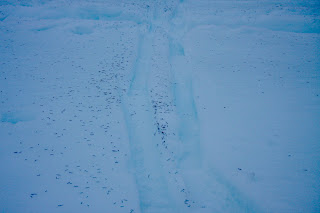
Getting closer to Scar Inlet, a remnant of the former Larsen B ice shelf, another surprise awaits us: blue open water as far as the eye can see. This is the same area we were not able to access by icebreaker last year. Now, there is no sea ice in sight, and summer hasn't even really started yet. The picture shows the Leppard and Flask Glacier entering the Scar Inlet. We are interested in how these glaciers will react if the ice shelf falls apart.
 The first landing side was on the Flask Glacier, where, last February, we installed a sophisticated weather station, that also measures the motion of the ice and uplinks data through the Iridium satellite phone system. We did some minor repairs here.
The first landing side was on the Flask Glacier, where, last February, we installed a sophisticated weather station, that also measures the motion of the ice and uplinks data through the Iridium satellite phone system. We did some minor repairs here. We had also installed a GPS station last February, which appears to be working just fine. So we didn't land there, but just flew by it. Imagine the surprise when we could still see the tracks that the airplane made (and even the sled tracks from hauling the batteries). These tracks were made more than nine months ago, before the southern winter. There was basically no snow fall here. At the same time, only a few kilometers away, at the top of the ridge, it has snowed about 10 m in the same time!
We had also installed a GPS station last February, which appears to be working just fine. So we didn't land there, but just flew by it. Imagine the surprise when we could still see the tracks that the airplane made (and even the sled tracks from hauling the batteries). These tracks were made more than nine months ago, before the southern winter. There was basically no snow fall here. At the same time, only a few kilometers away, at the top of the ridge, it has snowed about 10 m in the same time! After a stop on Leppard Glacier to fix solar panels, we landed about 4 km away from a GPS station on land. This is used to measure the rebound of the land, as the ice load is reduced. We did a small upgrade to that station and had a late evening hike back to the plane.
After a stop on Leppard Glacier to fix solar panels, we landed about 4 km away from a GPS station on land. This is used to measure the rebound of the land, as the ice load is reduced. We did a small upgrade to that station and had a late evening hike back to the plane.
Coming back to Rothera shortly before midnight we were treated with beautiful light as the sun was setting: the end of a successful day after two weeks of waiting.
















































